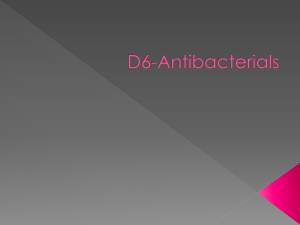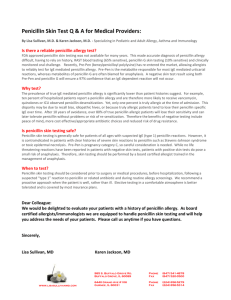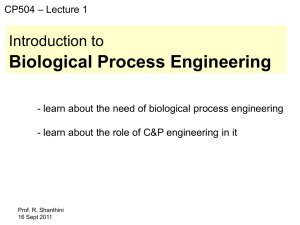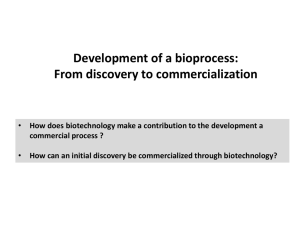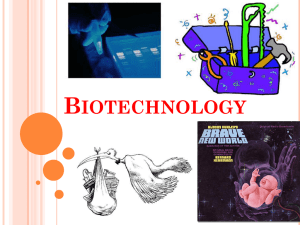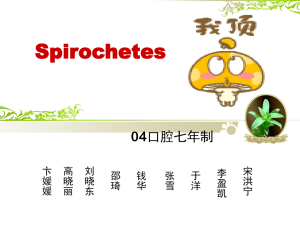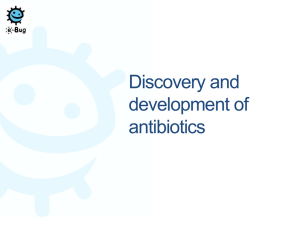Kenneth White and Community Penicillin
advertisement
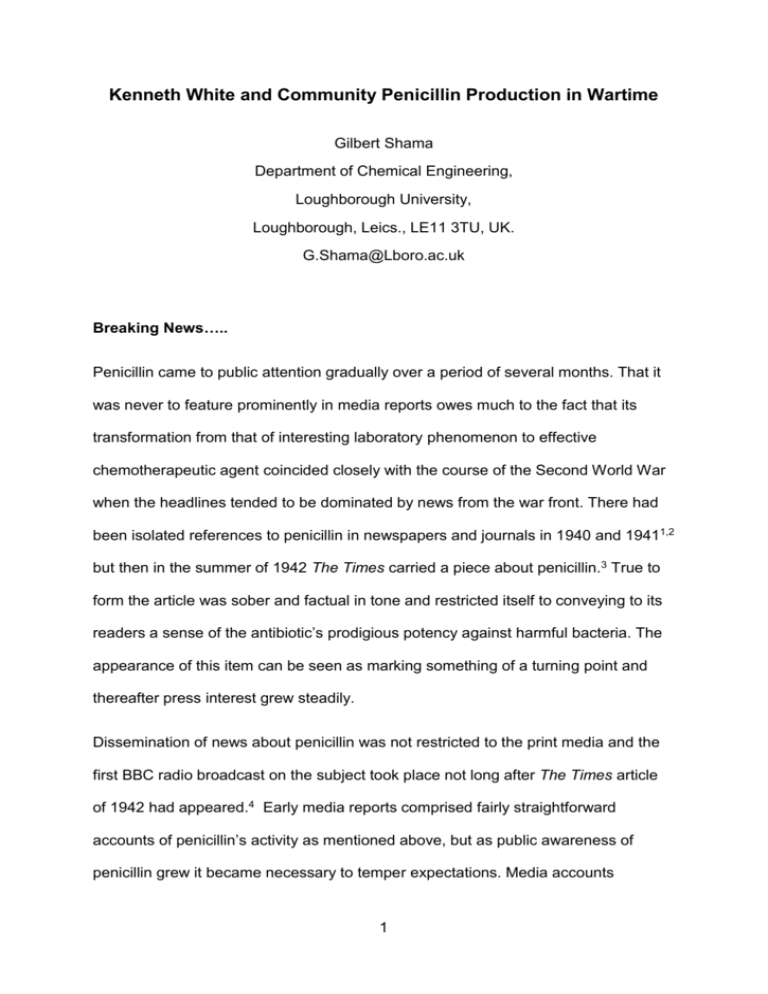
Kenneth White and Community Penicillin Production in Wartime Gilbert Shama Department of Chemical Engineering, Loughborough University, Loughborough, Leics., LE11 3TU, UK. G.Shama@Lboro.ac.uk Breaking News….. Penicillin came to public attention gradually over a period of several months. That it was never to feature prominently in media reports owes much to the fact that its transformation from that of interesting laboratory phenomenon to effective chemotherapeutic agent coincided closely with the course of the Second World War when the headlines tended to be dominated by news from the war front. There had been isolated references to penicillin in newspapers and journals in 1940 and 19411,2 but then in the summer of 1942 The Times carried a piece about penicillin.3 True to form the article was sober and factual in tone and restricted itself to conveying to its readers a sense of the antibiotic’s prodigious potency against harmful bacteria. The appearance of this item can be seen as marking something of a turning point and thereafter press interest grew steadily. Dissemination of news about penicillin was not restricted to the print media and the first BBC radio broadcast on the subject took place not long after The Times article of 1942 had appeared.4 Early media reports comprised fairly straightforward accounts of penicillin’s activity as mentioned above, but as public awareness of penicillin grew it became necessary to temper expectations. Media accounts 1 increasingly came to stress the fact that although production of penicillin was being scaled-up in Britain and the United States, all output was to be reserved exclusively for the armed forces with none being made available to the civilian population. Those at the forefront of penicillin research were recruited to help drive this message home; in a BBC radio broadcast in December 19435 Howard Florey of the Sir William Dunn School of Pathology at Oxford, stated that it was ‘very right and proper’ that penicillin should be reserved for the armed forces given its value in treating war wounds. This information would undoubtedly have served as a source of much comfort for the many with relatives in the armed forces. However, amongst the members of the public coming across media accounts on penicillin would also have been those who were suffering from intractable infections or those who were caring for relatives afflicted by such infections. To such persons the overwhelming effect of the steady media output exhorting the miraculous properties of a drug that was to all intents completely beyond reach must have been one of extreme frustration. As experience in the clinical applications of penicillin started to accumulate, case accounts began appearing with increasing frequency in the professional medical press and in learned journals. A consequence of this is that hospital doctors, general practitioners and pharmacists must have increasingly shared in the frustration felt by members of the public over penicillin’s general unavailability. There must have been many who fantasised about producing their own penicillin, but relatively few who were able to form a realistic assessment of what this would have entailed, and fewer still who would have been in any sort of position to actually attempt the undertaking. A pharmacist by the name of Kenneth White with a dispensary in the Surrey village of Ripley was able to do both. 2 O True Apothecary! Complete details for growing the Penicillium mould, extracting the penicillin and purifying it had been published by Florey in 1941.6 The preliminary process of cultivating the mould was relatively straightforward, but certain components of the growth medium would not have been generally available. This was not an insurmountable problem as ordinary food items such as sugar - heavily rationed though it was - could have served as substitutes. The purification of penicillin from crude mould juice was an altogether different undertaking, and would have required access to specific chemical reagents and water-immiscible solvents. This would have presented difficulties even to a pharmacist as the latter would have been reserved for industrial use relating directly to the war effort. However, once satisfactory growth had taken place separation of the mould pellicle from the liquid growth medium by filtration would have yielded a crude solution of penicillin. This could be filter-sterilised and used for treating superficial infections such as impetigo and carbuncles. Systemic administration of this solution would have been out of the question as the filtrate would have contained numerous other fungal metabolites as well as unutilised components of the growth medium. To undertake the manufacture of penicillin White would have needed a suitable strain of Penicillium notatum. He evidently did acquire one but how and when he did so remain unknown. He told a reporter from The Daily Mirror 7 that he started making penicillin in April 1944, which implies that he must have obtained a culture before this time. Notwithstanding this, White wrote to the Ministry of Supply on 30 th March 1944 requesting a ‘pure culture’ of P. notatum. Why he did so is therefore something of a mystery. It may be that by the term ’pure’ he meant the Fleming strain implying that the one he had come from a different source. Later in July of the same year he wrote 3 to the National Collection of Type Cultures (NCTC) with a similar appeal. Both requests were rejected. The reason for this is that an embargo had been placed on this particular culture to prevent German scientists from getting hold of it. 8 The authorities had an additional reason other than those having to do with security for rejecting White’s requests for cultures. The concept of ‘homemade penicillin’ had entered the public consciousness in the United States and articles had appeared in the press along with step-by-step guides as to how it might be effected.9 This raised the spectre of unqualified individuals dabbling in attempts to produce penicillin under unsuitable – and potentially hazardous - conditions. For example, failure to adequately sterilise all materials employed during manufacture could lead to contamination by environmental micro-organisms. It is of course technically feasible to attempt the isolation of a penicillin-producing strain from the environment, e.g. soil, but it is most unlikely that White took this course of action. Firstly, this would have required knowledge of mycology in advance of that normally possessed by pharmacists. Secondly, his professional training would have instilled in him the discipline of supplying drugs only from approved sources – typically as specified in The British Pharmacopeia. White told a newspaper reporter that he had visited a large penicillin manufacturing facility7 and in all likelihood he was given a culture during his visit. White might possibly have approached the Ministry of Supply and the NCTC because he was experiencing difficulties with the strain he had been culturing and this may have been because the stain he had was not suited ‘surface culture’ – the only practical means of growing the mould at his disposal. His approach to the Ministry of Supply was to have unforeseen consequences. In their refusal of his request they informed him that they were aware of his attempts to produce penicillin 4 from letters of his which had appeared in the ‘trade press’ and they demanded to know from where he had obtained his strain. Officials at the Ministry must have suspected a breach in security which they were intent on investigating. He evidently did not respond because he was written to again some three weeks after the first letter. It seems likely that if as suggested above one of the big penicillin manufacturers had indeed given White a culture it would have been strictly on the understanding that he would not reveal the fact to anyone. White must have possessed much basic laboratory equipment, but in taking the decision to culture Penicillium he was venturing into what was new territory for him, and he would have needed some specialised items of equipment. In obtaining the latter he was to demonstrate a great deal of resourcefulness. The penicillin filtrate would have had to be refrigerated so as not to lose activity, and White managed to obtain a refrigerator that had formerly been used to store ice cream at Lyons and Co. Ltd. – a chain of London coffee houses. Food rationing had rendered them redundant and the firm took the decision to support his endeavour. He was also able to obtain what was a state-of-the art vessel for culturing P. notatum. This was a spouted glass vessel manufactured by Chance Glass of Smethwick, Birmingham and based on the ceramic culture vessel designed by Norman Heatley at Oxford.6 The Daily Mirror described White as leading a ‘double existence,’ 7 by day supplying villagers with medicines but working far into the night to produce penicillin. White seems to have gone to great lengths to get all the information on the penicillin process he could. Having presumably exhausted all the British and American sources at his disposal, he approached the Soviet Embassy in London. It is unlikely that White believed that Soviet scientists had made advances over those of British and American researchers; more probably he was hoping that the Soviet authorities 5 might permit him to have sight of technical details passed onto them by their Western Allies, and which as an individual he would not normally be able gain access to. He was almost certainly disappointed in this belief. Resourceful and enterprising though he was, White was sufficiently pragmatic to acknowledge his limitations and to seek the co-operation of others when he needed to do so. Surviving correspondence shows that Dr R.C. Matson, a pathologist at the Royal Surrey County Hospital, undertook the assaying of White’s crude filtrates using the ‘Oxford’ strain of Staphylococcus aureus. This enabled them to quote their penicillin titres in ‘Oxford units’ (OU) and to compare their yields with those published in the literature. White evidently had developed ‘green fingers’ and was able to obtain titres as high as 15 OU/ml. This is a respectable yield particularly when viewed against those obtained by researchers at the American pharmaceutical company Merck only a year before.10 Matson along with other local physicians may also have identified suitable patients for White who in turn supplied them either with the crude filtrate or with a water-in-oil emulsion produced using lanette wax according to a procedure he had come across in The British Medical Journal.11 The emulsion was either applied to infected areas directly or bandages impregnated with the preparation were used. In association with a physician White published case notes of some 17 patients who had received treatment with his penicillin.12 Inevitably, the appearance of stories in the press about White’s success with penicillin led to his being contacted by members of the public desperate to obtain the antibiotic for friends and relatives. Some came from nearby locations such as Hove, and it is not inconceivable that White was occasionally able to satisfy such requests 6 particularly as he had established contacts with local physicians. But his fame had spread wide, and given the limitations he was working under would not have been able to accede to all such requests; the woman who wrote to him in July of 1944 from Montrose in Scotland would almost certainly have been disappointed. White’s efforts were to be greeted with admiration by a number of drug houses and other organisations. In recognition of his achievements Glaxo Laboratories supplied him with growth medium in tablet form for cultivating the mould. Bayer Products wrote to White congratulating him on being ‘the first pharmacist in [Britain] to produce penicillin filtrate for members of the public.’ The Pioneer Scientific Development and Research Society wrote to him in ‘cordial appreciation of [his] courageous efforts in the producing of penicillin under adverse circumstances and official apathy.’ White had trained as a pharmacist at Brighton Technical College and The Brighton and Hove Gazette sent a reporter to the college for ‘background’.13 The Head of the School of Pharmacy, Mr H. B. Mackie, when told of White’s achievements was quoted as stating simply that he was ‘not surprised.’ In February 1945 the Ministry of Supply sent White a culture of P. notatum and this gesture by the Ministry was tantamount to their bestowing official approval on his endeavours. White continued making and supplying penicillin after the war had ended. He was continually attempting to improve his production facilities, and an article published in the pharmacy trade press described how he had set up an enclosed ‘sterile area’ in his dispensary for preventing contamination during all stages of production.14 White had attempted without success to obtain a licence under the terms of the Therapeutic Substances Act, 1925 to conduct research in penicillin. This he hoped would have given him access to better strains of P. notatum 7 as well as lending legitimacy to his penicillin products. This was withheld from him during the war and finally only granted to him in July 1948. Kenneth White’s Achievements Working almost completely independently and unaffiliated to either a hospital, academic institution or research organisation Kenneth White succeeded in producing penicillin which was used in the treatment of patients. These patients were in the main afflicted with longstanding infections that had proved resistant to the only chemotherapeutic agents – the sulphonamides – their physicians had access to. Although running a business White’s motives were not pecuniary ones; all the evidence suggests that he appears to have borne all the associated production costs himself and that he made no charge for the penicillin. At a very rough estimate his efforts led to treatment of a few score of patients. These treatments were effected in a time of war in which millions of casualties and inestimable suffering were to result, and it would be wholly inappropriate to attempt to measure his impact against such criteria. The image of Kenneth White that emerges from the surviving evidence is of a man heavily imbued with a humanitarian spirit; learning of the existence of a compound that had the power to alleviate human suffering, he determined to do what he could with the limited resources available to him to provide it to as many people as he could reach. 8 References 1. Hope of a New Drug. The Scotsman 23 November 1940: 9. 2. A Vital Discovery. The Listener 9 October 1941: 505. 3. Penicillium. The Times 27 August 1942: 5. 4. BBC Radio Broadcast. Arial in Wartime 4 September 1942. 5. BBC Radio Broadcast. Penicillin 20 December 1943. 6. Abraham EP, Chain E, Fletcher CM et al. Further observations on penicillin. Lancet 1941;ii:177-189. 7. Ice Cream Frig. Gives Rare Drug to Village. The Daily Mirror 3 June 1944: 5. 8. Shama G. Zones of inhibition? The transfer of information relating to penicillin in Europe during World War II. Adv Appl Micro 2009; 69: 133-158. 9. Penicillin: Miracle Drug Produced in Times-Herald Test. Times-Herald 28 November 1943: D-3. 10. Raper KB, Alexander DF, Coghill RD. Penicillin: II. Natural variation and penicillin production in Penicillium notatum and allied species. J Bact 1944; 48: 639-659. 11. Alston J M. Crude penicillin filtrate for local treatment. BMJ 1944;1:654-656. 12. Creet RAF, White KE. Penicillin filtrate in general practice. Pharm J 1944, 23. September, 124 13. Ex-Brighton Student makes Penicillin in Back-Room “Lab”. Brighton and Hove Gazette 10 June 1944: 1. 14. A penicillin dispensary. Chemist Drugist; 7 September 1946. 9

